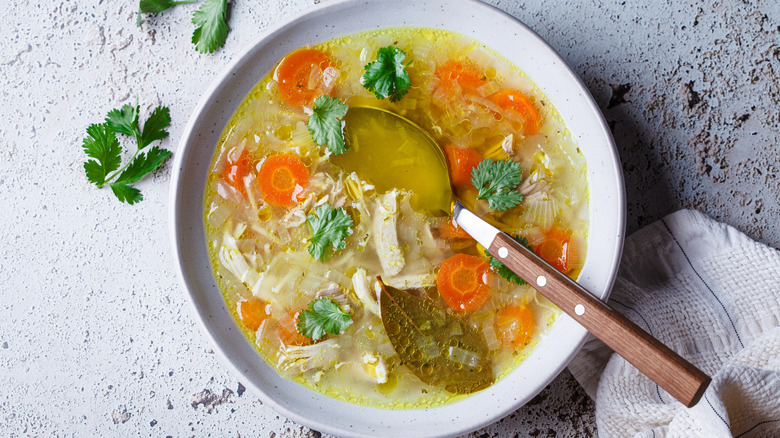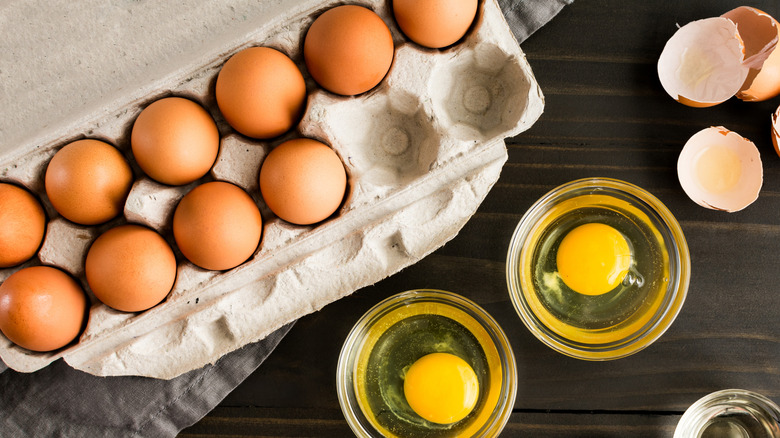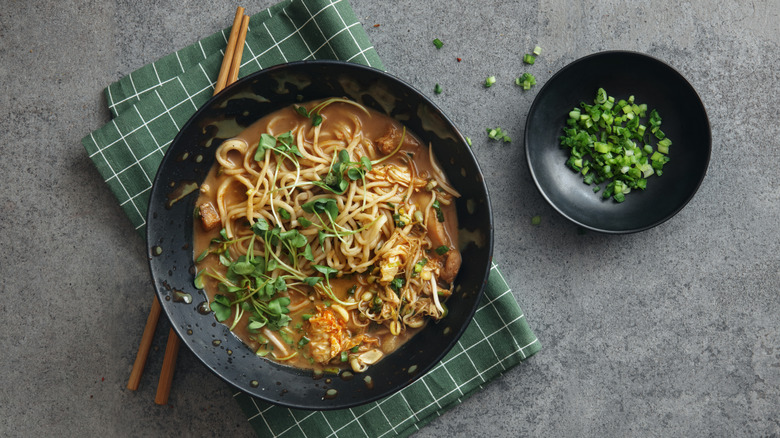Add This Breakfast Staple To Canned Chicken Noodle Soup For A Hearty Upgrade
Few foods are as comforting or nostalgic as a warm bowl of chicken noodle soup. It's perfect for chilly days or as a soothing remedy when you're feeling under the weather. While homemade soup is always delicious, when you're short on time (or too sick to cook), canned chicken noodle soup is the perfect substitute. Just heat it gently on the stove or in the microwave, and you've got a satisfying meal in minutes. The best part? It's super easy to upgrade with one simple yet hearty addition: eggs! To unpack why they make such a great add-in, Food Republic consulted Edmund McCormick, founder and CEO of Cape Crystal Brands.
"Whisking in eggs — like for the Italian stracciatella soup or Greek avgolemono — delivers delicate ribbons of protein to the brew," McCormick told us. "It adds instant body to many soups." When the hot liquid hits the beaten eggs, the proteins quickly denature, which is responsible for these fine strands forming. A classic example of this technique in action is Chinese egg drop soup, celebrated in traditional medicine for its nourishing properties and beloved worldwide for its comforting taste. Adding eggs to canned chicken noodle soup can bring a similar effect, making it even more soothing and hearty.
Alongside eggs elevating the texture, "The flavor gets slightly deeper," McCormick added. "The egg proteins catch on to particles of broth and spread seasoning that much more evenly in your mouth." Chicken noodle soup is already full of layered flavors, from the savory richness of the chicken to the subtle sweetness of simmered vegetables, so whisking in eggs is an easy way to make each spoonful taste even more balanced and satisfying.
The best way to add eggs to avoid clumping
Adding whisked eggs to a bowl of soup might seem simple, but it's surprisingly easy to get wrong. The moment the eggs hit the hot broth, they start to cook and thicken. If they're not incorporated properly, this can lead to thick clumps forming instead of smooth, silky strands. To avoid this, Edmund McCormick said, "The trick is tempering: In a small bowl, whisk a raw egg, and slowly drizzle in a ladle of hot broth while stirring. When the mixture is warm, pour back into the pot in a slow[,] steady stream while stirring." Rather than the eggs facing the shock of being added directly to the pot, this more gradual method allows the eggs to form into delicate ribbons by cooking under controlled heat — no scrambled egg soup here.
Just as you would when achieving the perfect egg ribbons in an egg drop soup, whisk a small amount of cornstarch slurry into the eggs before adding them to the soup. This serves a dual purpose by thickening the broth and stabilizing the egg proteins so that they set smoothly instead of clumping. Another thickening agent you could use is xanthan gum, which "suspends the vegetables, herbs[,] and egg ribbons evenly all through the soup[,] so nothing settles to the bottom," McCormick explained. He similarly suggested experimenting with guar gum and locust bean gum (the latter in conjunction with xanthan gum) to enhance the mouthfeel of the broth.
Another helpful tip is to stir the soup just before adding the eggs. This gentle circulation helps the eggs form fine, delicate strands instead of clumping together by going into stationary broth. You could also remove the soup from the heat and let it cool slightly. This allows the eggs to cook more gently, giving you more control over their shape and texture.
Seasonings that pair well with eggs in chicken noodle soup
Eggs are an excellent add-in to chicken noodle soup for both texture and flavor, and on top of that, there are plenty of other hacks to add extra flavor to canned soups. According to Edmund McCormick, "A squeeze of fresh lemon juice and a little bit of black pepper add brightness to the soup and help to counter its richness." Lemon juice is also helpful because acids stabilize egg proteins, allowing them to thicken evenly. Just think of delicious lemon-based egg soups like Greek avgolemono. You could also use citric acid, which provides a "clean, controlled tang," McCormick added. For a more Asian-style spin on chicken noodle soup, consider acids like rice wine vinegar or lime juice, which would pair perfectly with delicious additions such as scallions, ginger, or sesame.
Aromatics and spices are also a great way to add flavor and visual appeal. They're super customizable, and you can adjust them depending on your preferences. For a cozy autumnal version of chicken noodle soup, "Some dill, some parsley[,] and a bit of nutmeg" are great add-ins, McCormick told us. For even more depth, you can incorporate thyme, rosemary, or a bay leaf (which does have an effect, according to experts). If you're feeling under the weather, a pinch of turmeric can add antioxidant and anti-inflammatory benefits, while a little cayenne pepper or chili flakes can provide gentle heat and help clear congestion.



